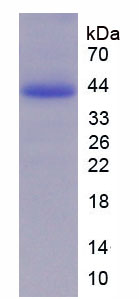Active Extracellular Signal Regulated Kinase 2 (ERK2)
MAPK1; P38; P40; ERK2; ERT1; MAPK2; P42MAPK; P42-MAPK; PRKM1; PRKM2; P41; P41mapk; P41-mapk; Mitogen-Activated Protein Kinase 1; Mitogen-activated protein kinase 2
- Product No.APA930Hu01
- Organism SpeciesHomo sapiens (Human) Same name, Different species.
- Buffer FormulationPBS, pH7.4, containing 0.01% SKL, 5% Trehalose.
- Traits Freeze-dried powder
- Purity> 95%
- Isoelectric Point7.0
- ApplicationsCell culture; Activity Assays.
- DownloadInstruction Manual
- UOM 10µg50µg 200µg 1mg 5mg
- FOB
US$ 321
US$ 803
US$ 1606
US$ 4818
US$ 12045
For more details, please contact local distributors!
ACTIVITY TEST

Extracellular Signal Regulated Kinase 2 (ERK2) is a 42-kDa protein serine/threonine kinase that is a member of the MAP kinase family. ERK2 is ubiquitously distributed in tissues with the highest expression in heart, brain, and spinal cord. Depending on the cellular context, the MAPK/ERK cascade mediates diverse biological functions such as cell growth, adhesion, survival and differentiation through the regulation of transcription, translation, cytoskeletal rearrangements. The MAPK/ERK cascade also plays a role in initiation and regulation of meiosis, mitosis, and postmitotic functions in differentiated cells by phosphorylating a number of transcription factors. It is reported that ERK2 can interact with STAT3 and treatment of cells with a MEK-ERK inhibitor blocks STAT3 S727 phosphorylation in response to IL-2. Thus a functional ELISA assay was conducted to detect the interaction of recombinant human ERK2 and recombinant human STAT3. Briefly, ERK2 was diluted serially in PBS with 0.01% BSA (pH 7.4). Duplicate samples of 100 μl were then transferred to STAT3-coated microtiter wells and incubated for 1h at 37℃. Wells were washed with PBST and incubated for 1h with anti-ERK2 pAb, then aspirated and washed 3 times. After incubation with HRP labelled secondary antibody for 1h at 37℃, wells were aspirated and washed 5 times. With the addition of substrate solution, wells were incubated 15-25 minutes at 37℃. Finally, add 50 µL stop solution to the wells and read at 450/630nm immediately. The binding activity of recombinant human ERK2 and recombinant human STAT3 was shown in Figure 1, the EC50 for this effect is 1.06 ug/mL.
USAGE
Reconstitute in 10mM PBS (pH7.4) to a concentration of 0.1-1.0 mg/mL. Do not vortex.
STORAGE
Avoid repeated freeze/thaw cycles. Store at 2-8°C for one month. Aliquot and store at -80°C for 12 months.
STABILITY
The thermal stability is described by the loss rate. The loss rate was determined by accelerated thermal degradation test, that is, incubate the protein at 37°C for 48h, and no obvious degradation and precipitation were observed. The loss rate is less than 5% within the expiration date under appropriate storage condition.
GIVEAWAYS
INCREMENT SERVICES
-
 BCA Protein Quantification Kit
BCA Protein Quantification Kit
-
 Molecular Mass Marker for Protein
Molecular Mass Marker for Protein
-
 Monoclonal Antibody Customized Service
Monoclonal Antibody Customized Service
-
 Polyclonal Antibody Customized Service
Polyclonal Antibody Customized Service
-
 Protein Activity Test Experiment Service
Protein Activity Test Experiment Service
-
 Electrophoretic Mobility Shift Assay (EMSA) Experiment Service
Electrophoretic Mobility Shift Assay (EMSA) Experiment Service
-
 Buffer
Buffer
-
 Lentivirus Packaging Experiment Service
Lentivirus Packaging Experiment Service
-
 Adenovirus Packaging Experiment Service
Adenovirus Packaging Experiment Service
-
 Real Time PCR Experimental Service
Real Time PCR Experimental Service
-
 Spike RBD Protein (S-RBD)
Spike RBD Protein (S-RBD)
-
 Protein G
Protein G
-
 Protein A
Protein A
| Magazine | Citations |
| Cellular and Molecular Neurobiology | Hypericum Perforatum Hydroalcoholic Extract Mitigates Motor Dysfunction and is Neuroprotective in Intrastriatal 6-Hydroxydopamine Rat Model of Parkinson’s Disease Pubmed:26119304 |
| Graefe's Archive for Clinical and Experimental Ophthalmology | Role of RhoA/MERK1/ERK1/2/iNOS signaling in ocular ischemic syndrome pubmed:27538909 |
| International Journal of Reproductive Medicine | Gonadotropin Stimulation Has Only a Limited Effect on the Concentration of Follicular Fluid Signalling Proteins: An Antibody Array Analysis 33575317 |









